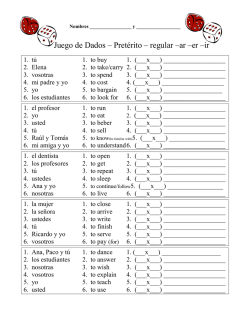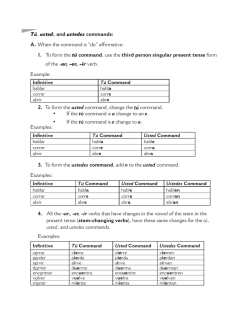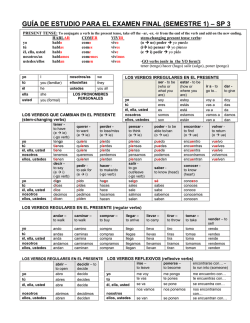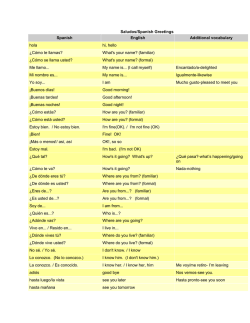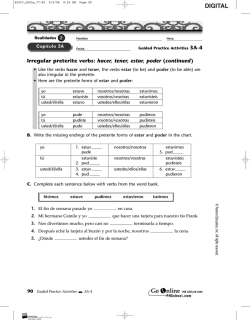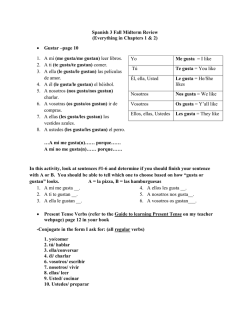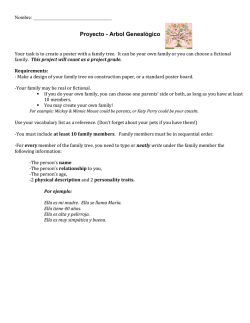
(yo) hablo I speak (usted) (él) habla he speaks (ella) (yo) como leat
Subject Pronouns
Thc subject, of a scntence tælls who is doing l.he action.
You ofton use pcople,e name6 as the subjec-t:
Gregorlo e¡cucha músíca.
Gregory û'Jten' to rhuJrc.
Ana canta y balla.
Ana srngr and dances.
You also use subjec0 pronouns (1, you, lw,
6he, we, tttey) la tell
who is doing an accion. The subject p*no*nË
oepl"oe people,s names:
Êl escucha
Ëlla canta
mrlsica.
y balla.
He /lsten¡ to ¿nusk.
Sfre s/ngs and dances.
T\1, usted, ustedzs,
Here are all the subject pronouns in Spanish:
yo
nosotros
norotras
tú
you (famíliar)
vosotros
vorotras
utted (Ud.) yöu (formal)
ét
ella
he
she
. Use
ellos
and uosoúros(as) all mean "you.'
with family, friends, people your
you call by his or her
we
we
fir¡t
age or youngeç and anyone
name.
.
Uee usted, with adults you address with a title, such as scñor; scrioro
profeaorb), etn, Usted is usually written as Ud.
. In Latin America, use ustedeo whon epeaking to two or more people,
regardless of age. Usted.e,s ie usually writtæn as Uds.
. In Spain, use uosoúrosfas/ when speaking to üwo or more people you
call úú individually: tú + t(t = uosotros(od, Use usúedes when lalking
t,o two or more people you call ueúed individually.
you
you
gstedes (Uds.) you (formal)
ellas
úú
they
they
You can combine a subject pronoun and a naine
tp form a subject,
AleJandro y yo =
Carlos y ella =
nosotros
sll65
Pepe y tú = ustedes
Lola y ella = ellJs
Verbs in the Present Tense
Present tense
('
of regular -ar verbs
Hablar'- To soeak
(yo) hablo I speak
(tú) hablas you (familiar) speak
(usted)
you (formal) speak
(él) habla he speaks
(ella)
she speaks
(nosotros/as)
hablamos
(vosotros/as)
habláis
(ustedes)
(ellos)
hablan
(e!as)
we speak
you (all) speak
plural, Spain
you (all) speak
they (mas.) speak
they (fem.) speak
Present tense of regular -er verbs
Comer - To eat
(yo) como leat
(tú) comes you (fami[iar) eat
(usted)
(él) come
(ella)
(nosotros/as) comeinos we eat
(vosotros/as) coméis
you (formal) eat
he eaß
(ustedes)
(ellos)
she eats
(ellas)
comen
you (all) eat
plural, Spain
you (all) eat
they (mas.) eat
they (fem.) eat
Present tense of regular -ir verbs
Escribir - To write
(yo) escrih I wrìte
(tú) escribes you (famìliar) write
(usted)
(él) escribe
(ella)
(nosotrolas) escribimos we write
(vosotros/as) escribís
you (all) write
plural,
you (formal) write
he writes
'slrc
writes
(ustedes)
(ellos)
32
(ellas)
escriben
Spain
you (all) write
they (mas.) write
they (fem.) write
iL
Vqmos
o procticor
o. ¿ Quién es ?
Indicate which pronoun-yo, tú, usted, ella, él-you would use
with the following people. Each pronoun may be used more than once,
L. your mother, when you are talking to her
2, your father, when you are talking about him
3. a male friend you are talking about
4. a close friend you are talking
5. a female friend you are talking about6. you, talking about yourself
7. a teacher you are talking to
8. your aunt, when you are talking about her
b. ¿Tú o usled?
Would you use tú or usted to address the following people?
1. your sister
2.
3.
4.
5.
6.
7.
the principal of your school
your Spanish teacher
your teenage cousin
the classmate who sits behind you
a clerk at the store
your best friend
8. the guidance counselor
c. Am¡gos y profesotes. Which pronoun would you use to refer to the
following people?
MODELO Pablo es mi amigo.
É/ es mi amigo.
l. Diana es mi amiga.
2. La Srta. Montero es r¡i profesora.
3. Et Sr. Whitaker es mi profesor de
4, Alicia es mi amiga.
5, Juan es mi amigo.
El Sr Pérez es el director de la escuela.
7. La Sra. Ramos es mi profesora de mate
6.
8, José es mi amigo
Ch. FOIOS. A Mexican friend, Pilar, is showing you
some photos she took at school.
would you
You are curious to know who the people in the photographs are' What
ask her?
¿Quién es él?
Es mi amigo Pablo
MODELO Tú:
Pilar:
Esm
2. Tú:
L
Pilar:
3. Tú:
Pilar:
4. Tú:
Pilar:
5. lu:
¿...
1. Tú:
Pilar:
Pilar:
,|
6. Tú:
Pilar:
Es el Sr. Morales.
7.
t'l
(J'
Es mi amigo Ratael.
L
?
Es mi amiga Teresa.
Tí:
Pilar:
8. Tú:
Pilar:
33
L
Es el
matemáticas.
¿ ' . .?
Es mi amigo Sarnuel.
..t
Ll
Es Luisa, mi buena amiga.
¿. . '?
¡Caramba! ¡Soy yo!
Vqmos
o procticor
o. ¿Quiénes?
What subject pronouns would you use to talk about the following
people?
MODELO Carlos y yo
nosotros
4. tú y tir
5. ustedes y el profesor
6. usted y yo
L. Carlota y María
2. mi amiga y yo
3. Manuel y Andrés
b.
¿
Uno o mós
?
7. ti y Juan
8. rú yyo
9. tú y ella
Make the singular pronouns plural and the plural pronouns
singular.
MODELO ustedes
usted
4. él
5. usted
6. ellas
1. yo
2. nosotros
3. rú
7. ustedes
8. ellos
9. nosotras
PRACTICE THE ST]BJECT PRONOUNS
^. \ilhich pronoun is always capitalized in English but not in Spanish?2. The pronoun wehas two possible worÇ,s iu Spanish:
3. Vosotros ís the plural
in Spain, but it is not used in Latin
America. In its place, Latin Americaru¡ use
4. \it¡hich one is more familiar; tú or usted?
5. JVosotros ie used when all the speakers are
, but
trcsotros can be all males or a combination of males and
6. If Mr. Pérez is talking for himself and his wife, will he say r¿osotros or
nosotras?
?. The use of úú versus
usted varies from country to'country. A student would
address his teacher as
, and the teacher wouïd reply with
8. The mark (') on a vowel in Spanish is called
acento, and later you
will learn
the rules for its use.l¡rrhich are the üwo pronouns with acento?
9. Heis always a person (or animal) as subject of a sentence; the Spanish woro
is
. The pronoun for s/¿e is
. Ttre pronoun for íú is
34
"
T
**: ii,i i;-; ;: :ïi".iî ;:':i; :::,:iJÏ;::;:
Spanísh word is
11. If we talk about the tables, we refer to thern as they if the word is the subject
ofthesentence.\¡/ouldyoutrans|atethey(tables)inthiscase?_
LZ. One easy wayto tellttlfrom ustedis to compare with English. When you call
a person by his or her first name (John, Mary, etc), you would use úú. When
you use last names (Mr. Martfnez), You would use
in Spanish.
, and ustedes
t3. Usted is abbreviated into
Llena el cuadro con los pranombres personales en español.
PLURAL
SINGULAR
7*persona
Fpersona
Fpersona
35
© Copyright 2025
